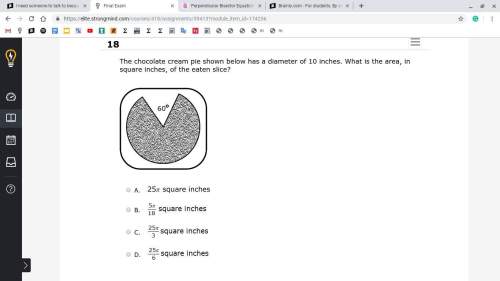
Mathematics, 23.02.2020 03:26 queeneaf
An ordinary (fair) coin is tossed 3 times. Outcomes are thus triples of "heads" (h) and tails" (t) which we write hth, ttt, etc. For each outcome, let R be the random variable counting the number of tails in each outcome. For example, if the outcome is hhh, then =Rhhh0. Suppose that the random variable X is defined in terms of R
as follows: =X−R2. The values of X are thus: Outcome ttt htt tht hth thh hhh tth hht
Value of
X 1 0 0 −1 −1 −2 0 −1
Calculate the probability distribution function of X, i. e. the function pXx. First, fill in the first row with the values of X. Then fill in the appropriate probabilities in the second row.

Answers: 1


Another question on Mathematics

Mathematics, 21.06.2019 15:30
Acircular city park has a sidewalk directly through the middle that is 111 - feet long. if each bag of fertilizer covers 50 square feet, then determine how many bags of fertilizers the parks and recreation department needs to use to cover the circular park. ignore all the sidewalks around and through the park.
Answers: 1

Mathematics, 21.06.2019 17:30
Which of the following equations is of the parabola whose vertex is at (2, 3), axis of symmetry parallel to the y-axis and p = 4? a.)y-3 = 1/16 (x-2)^2 b.)y+3 = -1/16 (x+2)^2 c.)x-2 = 1/16 (y-3)^2
Answers: 3

Mathematics, 21.06.2019 19:00
What is the factored form of the following expressions? d^2 – 13d + 36
Answers: 2

Mathematics, 22.06.2019 01:30
What is the value of x enter your answer in the box (3x+50
Answers: 2
You know the right answer?
An ordinary (fair) coin is tossed 3 times. Outcomes are thus triples of "heads" (h) and tails" (t) w...
Questions

Social Studies, 19.01.2022 19:40

Social Studies, 19.01.2022 19:40









Social Studies, 19.01.2022 19:40

History, 19.01.2022 19:40

SAT, 19.01.2022 19:40

SAT, 19.01.2022 19:40

Mathematics, 19.01.2022 19:40

Mathematics, 19.01.2022 19:40

Mathematics, 19.01.2022 19:50



Chemistry, 19.01.2022 19:50




